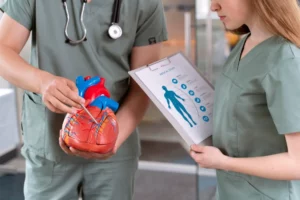 An aortic aneurysm is a serious medical condition characterized by a bulging or ballooning of the aorta, the largest blood vessel in the body.
An aortic aneurysm is a serious medical condition characterized by a bulging or ballooning of the aorta, the largest blood vessel in the body.
Understanding the causes, symptoms, and treatment options for aortic aneurysms is essential for early detection and intervention. Regular health check-ups, especially for individuals with risk factors, contribute to the proactive management of this potentially serious condition.
Defining Aortic Aneurysm
An aortic aneurysm occurs when a weakened area of the aortic wall allows it to bulge outward. This can happen in different segments of the aorta, including the ascending aorta, the arch, and the descending aorta.
Causes of Aortic Aneurysm
Aortic aneurysms can result from a variety of factors, including:
- atherosclerosis (hardening of the arteries),
- genetic conditions,
- trauma,
- or inflammation of the aorta.
Types of Aortic Aneurysms
- Thoracic Aortic Aneurysms: These occur in the upper part of the aorta and can extend into the chest.
- Abdominal Aortic Aneurysms: These develop in the lower part of the aorta, often in the abdominal region.
Symptoms of Aortic Aneurysm
- Often Asymptomatic: Aortic aneurysms may not cause symptoms until they rupture. Regular medical check-ups and imaging studies are crucial for early detection.
- Symptomatic Aneurysms: Some individuals may experience symptoms such as chest or back pain, shortness of breath, difficulty swallowing, or a pulsating sensation in the abdomen.
Diagnosis and Monitoring
- Imaging Studies: Diagnostic tools such as ultrasound, CT scans, or MRI.
- Regular Monitoring: to track any changes in size.
Treatment Options
- Medical Management: Blood pressure control and lifestyle modifications.
- Surgery: For larger aneurysms or those at risk of rupture, surgical intervention may be necessary. This can involve open surgery or endovascular repair.
Risk Factors for Aortic Aneurysm
- Age and Gender: Aortic aneurysms are more common in older individuals and are often seen in men.
- Genetics: Family history can play a significant role, and certain genetic conditions may predispose individuals to aortic aneurysms.
Importance of Timely Intervention
Aortic aneurysms pose a significant risk of rupture, which can be life-threatening. Timely diagnosis and appropriate management are critical for preventing complications.
If you suspect you may be at risk or are experiencing symptoms, seek prompt medical attention for thorough evaluation and personalized care.
Picture Credit: Freepik
